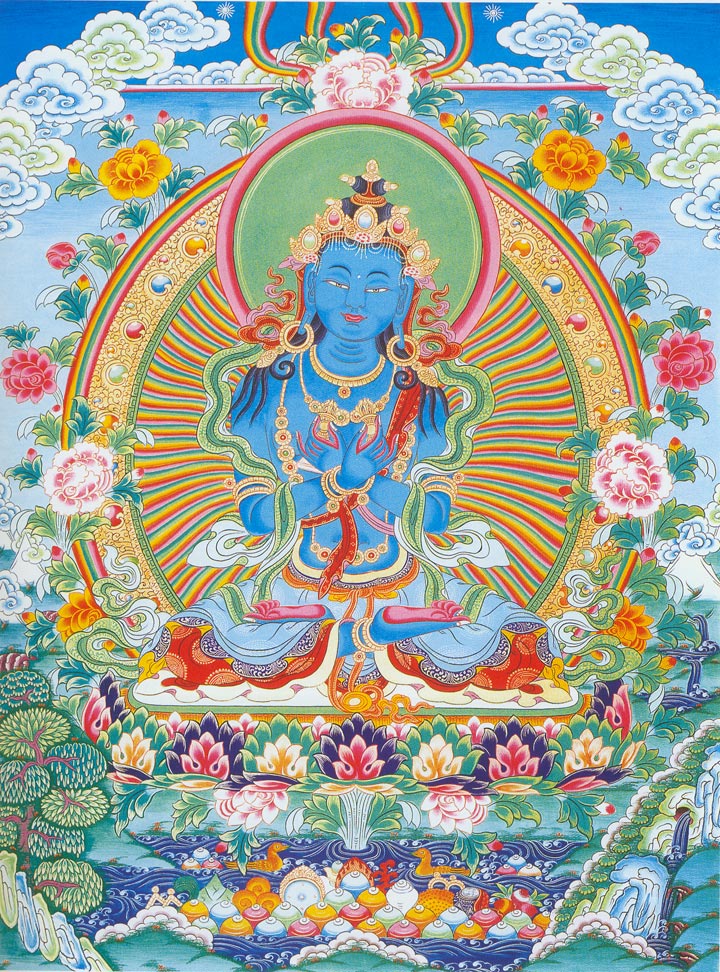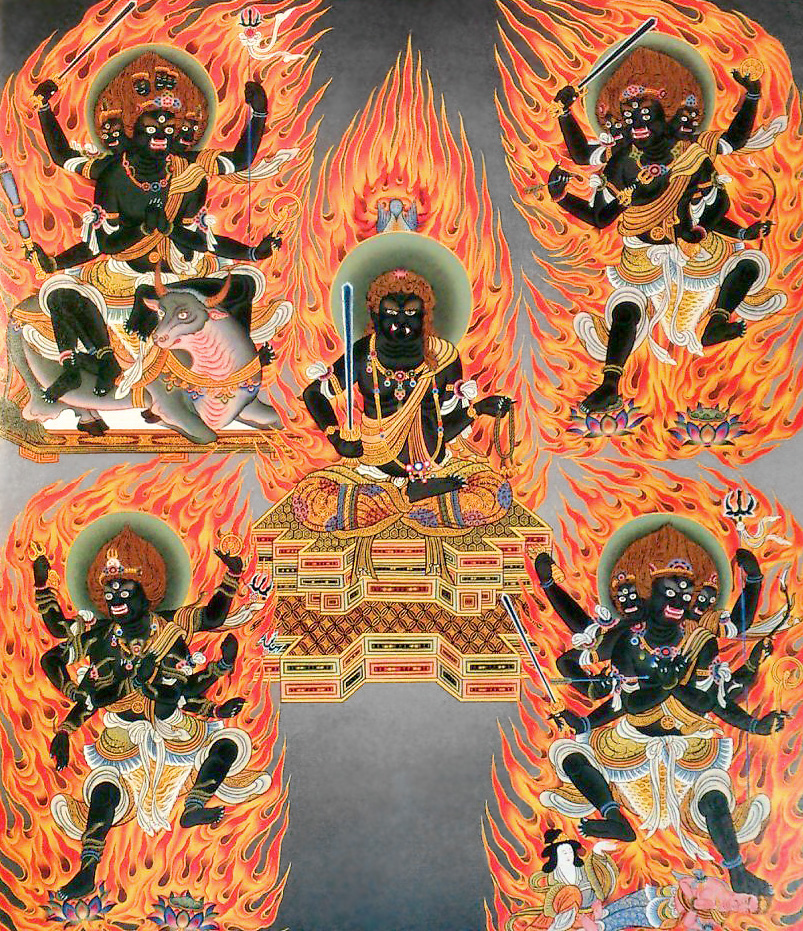|
Thirteen Buddhas
The is a Japanese grouping of Buddhist deities, particularly in the Shingon and Tendai sects of Buddhism. The deities are, in fact, not only Buddhas, but also include bodhisattvas. In Shingon services, lay followers recite a devotional mantra to each figure, though in Shingon practice, disciples will typically devote themselves to only one, depending on what the teacher assigns. The chanting of the mantras of the Thirteen Buddhas is a basic practice followed by Shingon and Tendai lay followers. They are also important in funeral and apotropaic / protective rituals. Funeral rituals The Thirteen Buddhas are also an important part of a traditional Japanese Buddhist funeral service, with each deity having a corresponding memorial service for the deceased. The names of the thirteen figures are given below in Japanese and Sanskrit and the corresponding date of their service after the death: # Fudō (Acala), 7th day # Shaka (Sakyamuni), 14th day # Monju (Manjushri), 21st day # ... [...More Info...] [...Related Items...] OR: [Wikipedia] [Google] [Baidu] |
Thirteen Buddhist Deities, Japan, Nambokucho-Muromachi Period, C
Thirteen or 13 may refer to: * 13 (number) * Any of the years 13 BC, AD 13, 1913, or 2013 Music Albums * ''13'' (Black Sabbath album), 2013 * ''13'' (Blur album), 1999 * ''13'' (Borgeous album), 2016 * ''13'' (Brian Setzer album), 2006 * ''13'' (Die Ärzte album), 1998 * ''13'' (The Doors album), 1970 * ''13'' (Havoc album), 2013 * ''13'' (HLAH album), 1993 * ''13'' (Indochine album), 2017 * ''13'' (Marta Savić album), 2011 * ''13'' (Norman Westberg album), 2015 * ''13'' (Ozark Mountain Daredevils album), 1997 * ''13'' (Six Feet Under album), 2005 * ''13'' (Suicidal Tendencies album), 2013 * ''13'' (Solace album), 2003 * ''13'' (Second Coming album), 2003 * 13 (Timati album), 2013 * ''13'' (Ces Cru EP), 2012 * ''13'' (Denzel Curry EP), 2017 * ''Thirteen'' (CJ & The Satellites album), 2007 * ''Thirteen'' (Emmylou Harris album), 1986 * ''Thirteen'' (Harem Scarem album), 2014 * ''Thirteen'' (James Reyne album), 2012 * ''Thirteen'' (Megadeth album), 2011 * ... [...More Info...] [...Related Items...] OR: [Wikipedia] [Google] [Baidu] |
Mahasthamaprapta
Mahāsthāmaprāpta is a bodhisattva mahāsattva who represents the power of wisdom. His name literally means "arrival of the great strength". Mahāsthāmaprāpta is one of the Eight Great Bodhisattvas in Mahayana Buddhism, along with Mañjuśrī, Samantabhadra, Avalokiteśvara, Ākāśagarbha, Kṣitigarbha, Maitreya and Sarvanivarana-Vishkambhin. In Chinese Buddhism, Mahasthamaprapta is sometimes portrayed as a woman, Dashizhi, with a likeness similar to Avalokiteśvara (known as Guanyin in China). He is also one of the Thirteen Buddhas in the Japanese school of Shingon Buddhism. In Tibetan Buddhism, Mahāsthāmaprāpta is equated with Vajrapani, who is one of his incarnations and was known as the Protector of Gautama Buddha. Mahāsthāmaprāpta is one of the oldest bodhisattvas and is regarded as powerful, especially in the Pure Land school, where he takes an important role in the '' Longer Sukhāvatīvyūha Sūtra''. He is often depicted in a trinity with Amitābha ... [...More Info...] [...Related Items...] OR: [Wikipedia] [Google] [Baidu] |
Chinese Zodiac
The Chinese zodiac is a traditional classification scheme based on the Chinese calendar that assigns an animal and its reputed attributes to each year in a repeating twelve-year (or duodenary) cycle. The zodiac is very important in traditional Chinese culture and exists as a reflection of Chinese philosophy and Chinese culture, culture. Chinese folkways held that one's personality is related to the attributes of their zodiac animal. Originating from China, the zodiac and its variations remain popular in many East Asian and Southeast Asian Sovereign state, countries, such as Japan, South Korea, Vietnam, Singapore, Nepal, Bhutan, Cambodia, and Thailand. Identifying this scheme as a "''zodiac''" reflects superficial similarities to the western astrology, Western zodiac: both divide time cycles into twelve parts, label the majority of those parts with animals, and are used to ascribe a person's personality or events in their life to the person's particular relationship to the cycle. ... [...More Info...] [...Related Items...] OR: [Wikipedia] [Google] [Baidu] |
Earthly Branches
The Earthly Branches (also called the Terrestrial Branches or the 12-cycle) are a system of twelve ordered symbols used throughout East Asia. They are indigenous to China, and are themselves Chinese characters, corresponding to words with no concrete meaning other than the associated branch's ordinal position in the list. Cultural applications of the Branches include a dating system known as the sexagenary cycle, and their use in Chinese astrology. They are associated with the ten Heavenly Stems in Chinese calendars, and in Taoist practice. Overview The twelve Earthly Branches are: The branches each have specific names in the languages of the Sinosphere—which include Chinese, Japanese, Korean, Turkic, Vietnamese, and Mongolian. Branches are commonly used when counting in a manner similar to how letters are used according to their alphabetical ordering. In addition to the calendar months, each branch has been associated with several distinct cultural categori ... [...More Info...] [...Related Items...] OR: [Wikipedia] [Google] [Baidu] |
Adibuddha
The Ādi-Buddha (, Ch: 本佛, Jp: honbutsu, First Buddha, Original Buddha, or Primordial Buddha) is a Mahayana Buddhist concept referring to the most fundamental, supreme, or ancient Buddha in the cosmos. Another common term for this figure is Dharmakāya Buddha. The term emerges in tantric Buddhist literature, most prominently in the Kalachakra. "Ādi" means "first", such that the Ādibuddha was the first to attain Buddhahood. "Ādi" can also mean "primordial", not referring to a person but to an innate wisdom that is present in all sentient beings. In East Asian Buddhism, the term 本佛 (běn fó, original Buddha, root Buddha) also appears in the works of Tiantai and Tendai school, referring to the original Buddha of the ''Lotus Sutra'' which was also later identified with the cosmic Buddha Mahavairocana. It and similar terms were also used in the traditions of Chinese Esoteric Buddhism and Shingon to refer to the cosmic Buddha Mahavairocana. Indian sources According ... [...More Info...] [...Related Items...] OR: [Wikipedia] [Google] [Baidu] |
Manjushri
Manjushri () is a ''bodhisattva'' who represents '' prajñā'' (transcendent wisdom) of the Buddhas in Mahāyāna Buddhism. The name "Mañjuśrī" is a combination of Sanskrit word " mañju" and an honorific " śrī"; it can be literally translated as "Beautiful One with Glory" or "Beautiful One with Auspiciousness". Mañjuśrī is also known by the fuller name of Mañjuśrīkumārabhūta (),Keown, Damien (editor) with Hodge, Stephen; Jones, Charles; Tinti, Paola (2003). ''A Dictionary of Buddhism.'' Oxford, UK: Oxford University Press. p.172. literally "Mañjuśrī, Still a Youth" or, less literally, "Prince Mañjuśrī". Another name of Mañjuśrī is Mañjughoṣa. In Mahāyāna Buddhism Scholars have identified Mañjuśrī as the oldest and most significant bodhisattva in Mahāyāna literature. Mañjuśrī is first referred to in early Mahāyāna sūtras such as the Prajñāpāramitā ''sūtra''s and through this association, very early in the tradition he came to symboli ... [...More Info...] [...Related Items...] OR: [Wikipedia] [Google] [Baidu] |
Siddhartha Gautama
Siddhartha Gautama, most commonly referred to as the Buddha (),* * * was a śramaṇa, wandering ascetic and religious teacher who lived in South Asia during the 6th or 5th century BCE and founded Buddhism. According to Buddhist legends, he was born in Lumbini, in what is now Nepal, to royal parents of the Shakya clan, but Great Renunciation, renounced his Householder (Buddhism), home life to live as a wandering ascetic. After leading a life of mendicancy, asceticism, and meditation, he attained Nirvana (Buddhism), nirvana at Bodh Gaya, Bodh Gayā in what is now India. The Buddha then wandered through the lower Indo-Gangetic Plain, teaching and building a Sangha, monastic order. Buddhist tradition holds he died in Kushinagar and reached ''parinirvana'' ("final release from conditioned existence"). According to Buddhist tradition, the Buddha taught a Middle Way between sensual indulgence and severe asceticism, leading to Vimutti, freedom from Avidyā (Buddhism), ignora ... [...More Info...] [...Related Items...] OR: [Wikipedia] [Google] [Baidu] |
Acala
or Achala (, "The Immovable", ), also known as (, "Immovable Lord") or (, "Noble Immovable Lord"), is a Fierce deities, wrathful deity and ''dharmapala'' (protector of the Dharma) prominent in Vajrayana, Vajrayana Buddhism and East Asian Buddhism., Jp. rel. dict., pp. 242–246 Originally a minor deity described as a messenger or acolyte of the Buddhahood, buddha Vairocana, Acala later rose to prominence as an object of veneration in his own right as a remover of obstacles and destroyer of evil, eventually becoming seen as the wrathful manifestation of either Vairocana, the buddha Akshobhya, Akṣobhya, or the bodhisattva Manjushri, Mañjuśrī. In later texts, he is also called (, "Violent Wrathful One", ) or (, "Violent One of Great Wrath", ), the names by which he is more commonly known in countries like Nepal and Tibet. In East Asian Buddhism, East Asian Chinese Esoteric Buddhism, esoteric Buddhism, Acala is classed among the Wisdom Kings () and is preeminent among the ... [...More Info...] [...Related Items...] OR: [Wikipedia] [Google] [Baidu] |



